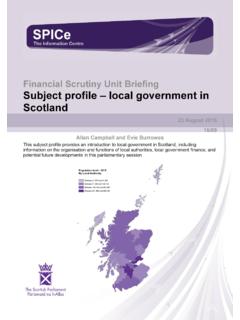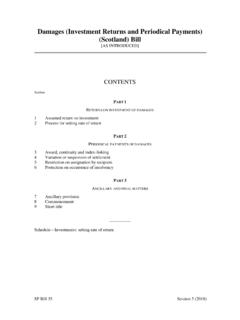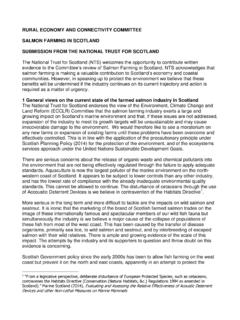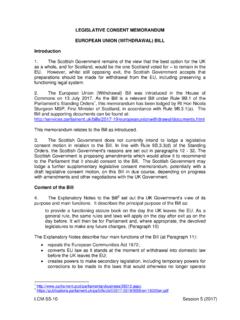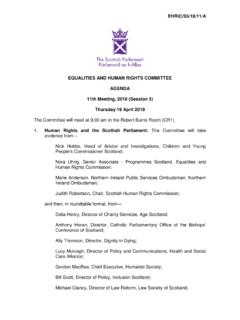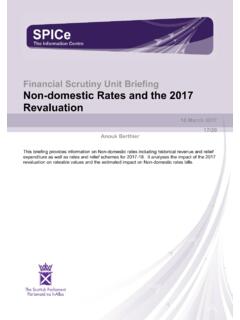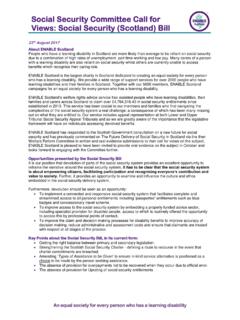Transcription of SPICe Briefing Kinship Care - Scottish Parliament
1 The Sc ot tish Parliament and Scottis h Parliament I nf or mation C entre l ogos . SPICe Briefing Kinship care 04 November 2016 16/87 Camilla Kidner Recent legislation has made adjustments to the legal framework for Kinship care , and new regulations set out new forms of assistance and allowances. This Briefing provides an overview of Kinship care . It uses Census information and Scottish Government statistics to estimate the numbers of looked after and non-looked after children in Kinship care . It sets out the different requirements for local authority assistance and briefly looks at the effect this has on social security benefits.
2 This Briefing updates SPICe Briefings SB 12/05 and SB 08/03 and states the law as at April 2016. 2 CONTENTS CONTENTS .. 2 EXECUTIVE SUMMARY .. 3 WHAT IS Kinship care ? .. 4 LEGAL BASIS OF Kinship care .. 4 POLICY BACKGROUND .. 5 NUMBERS AND CHARACTERISTICS OF Kinship CARERS .. 7 AGE AND ECONOMIC ACTIVITY .. 7 DEPRIVATION .. 9 DISABILITY AND HEALTH .. 10 PROBLEMS EXPERIENCED BY Kinship CARERS .. 11 TREND IN USE OF LOOKED AFTER PLACEMENTS .. 11 Geographical 11 Change over time .. 12 ASSESSMENT AND PLANNING LOOKED AFTER PLACEMENTS .. 14 PLANNING FOR PERMANENCE .. 15 Permanence Order .. 16 Section 11 Order/ Kinship care Order.
3 16 CHILDREN NOT LOOKED AFTER BY THE LOCAL AUTHORITY .. 17 COURT ORDERS AND Kinship care ASSISTANCE .. 17 Section 11 Orders .. 17 Guardianship .. 18 Kinship care assistance .. 18 Additional assistance for children at risk of being looked after .. 18 Leaving Kinship care .. 19 NO COURT ORDER .. 19 Children 'in need' .. 19 LOCAL AUTHORITY PAYMENTS TO Kinship CARERS .. 19 LEGAL PROVISION TO PAY ALLOWANCES .. 20 POLICY AGREEMENT ON FINANCIAL ALLOWANCES .. 21 'On a par with foster carers' .. 21 A national rate .. 21 RATES PAID IN 2016 .. 22 EFFECT OF LOCAL AUTHORITY PAYMENTS ON SOCIAL SECURITY BENEFITS .. 23 Child Benefit.
4 24 Child Tax Credit .. 24 Universal Credit .. 24 Counted As Income .. 25 Two child rule .. 25 ADVICE AND SUPPORT FOR Kinship CARERS .. 26 ANNEX 1: BECOMING LOOKED AFTER .. 27 ANNEX 2: LEGISLATION RELATING TO Kinship care PAYMENTS .. 28 SOURCES .. 32 RELATED BRIEFINGS .. 34 3 EXECUTIVE SUMMARY Kinship care is the care of children by their extended family or a close friend of the family. It includes formal care for children who are looked after by the local authority. It also includes informal arrangements made privately between family members without local authority involvement. The 2011 Census suggests that there are between 11,000 and 17,000 children living in Kinship care .
5 Of these, around 4,000 are looked after by the local authority. ( Looked after children are those placed by the local authority in foster, residential or Kinship care . It also includes those living at home, but with an element of social work supervision). The number of looked after children placed in Kinship care has been increasing and they now make up 27% of all looked after placements. The main policy developments over the last 10 years have been the increasing use of Kinship care as placements for looked after children and the provision of financial allowances by local authorities. Since 2014, there has been an increasing focus on supporting Kinship carers of children who were previously looked after or at risk of being looked after.
6 Where a child is looked after , the local authority must provide support, including a financial allowance. Since April 2016, support must also be provided if the child was previously looked after or is at risk of being looked after . The actual amount provided is at the discretion of the local authority. There is a policy agreement between the Scottish Government and COSLA that it should be on a par with payments to foster carers. The Kinship allowance does not include fees paid to the foster carer. It will take into account the receipt of social security benefits by the Kinship carer that foster carers are not entitled to.
7 In practice therefore, the actual payments made to foster carers may still be different to those made to Kinship carers. In the long term, the Scottish Government intends to introduce a national allowance. In other circumstances, local authorities have discretion over whether to provide financial support. The interaction between local authority allowances and the benefits system is complex. For example, where a child is looked after , the Kinship carer, like foster carers, will not be entitled to the child element of Universal Credit. If they are getting a payment from the local authority for 'accommodation and maintenance', then they will not be entitled to Child Tax Credit.
8 These issues do not affect Kinship carers of non- looked after children. Notwithstanding the considerable policy attention over the last ten years, a number of issues remain to be resolved concerning support for Kinship carers. These include: The interaction of the benefits system with local authority allowances Variation in practice between local authorities Identifying with more certainty the level of unmet need amongst Kinship carers of non- looked after children 4 WHAT IS Kinship care ? A Kinship carer is a relative or friend who takes over the care of a child when their parents cannot look after them.
9 For many children, there is no state involvement as the Kinship care is a completely private arrangement between members of an extended family. In some cases the carers apply to the court for an order giving them some parental rights and responsibilities (Section 11 Order). Other children in Kinship care may be looked after by the local authority and placed with relatives or friends as an alternative to foster care . Kinship carers may offer to look after a child or they may be asked to do so by social workers. Where there is a crisis situation they may have very little time to prepare for caring for children. Kinship care has some similarities with fostering in that it offers an alternative to residential care for children who cannot live with their parents.
10 However, a fundamental difference is that Kinship carers are offering to look after a particular child rather than providing placements for any children requiring care . They therefore provide something which is between the public intervention of local authority placements and private family care . Exactly where they are on this spectrum depends on the circumstances of the individual case. The degree of variation in such arrangements makes this a complex policy area. LEGAL BASIS OF Kinship care The level of support received by a Kinship carer will often depend on the legal status of the child in particular whether or not they are looked after or have a ' Kinship care order' (section 11 order) under the Children (Scotland) Act 1995 (the 1995 Act).
